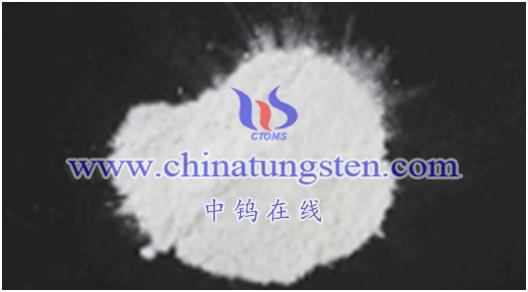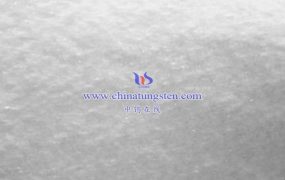12 phosphotungstic acid, 12 tungstophosphoric acid (English: Phosphotungstic Acid), referred to as PTA, the English name is also called Tungstopphosphoric Acid, referred to as TPA, is a heteropoly acid with the chemical formula H3PW12O40, usually in the form of hydrate, PTA is phosphotungstic Abbreviation for acid ethanol solution, commonly used in biology.
Phosphotungstic acid is small particles, gray or light yellow-green crystals, melting point is 89°C (24H2O hydrate), phosphotungstic acid is soluble in water (200g/100ml), and its aqueous solution is colorless. Phosphotungstic acid has no significant toxicity and is a slightly acidic irritant. The ion of phosphotungstic acid contains 12 tungsten atoms. Some early researchers called it phosphorous-24-tungstic acid. Incorrect, but the ratio is correct, until the 1970s, there are papers using this incorrect chemical formula. In histology, phosphotungstic acid is commonly used in the staining of cell samples, and it is often used together with hematoxylin, called phosphotungstic acid-hematoxylin staining (English: PTAH).
Phosphotungstic acid will combine with fibrin, collagen and fibers in connective tissue to form different colors. Phosphotungstic acid is an electron-dense substance that is opaque under electrons. In transmission electron microscopy, phosphotungstic acid can be used to negatively stain viruses, nerves, polysaccharides and other biological tissues. Gouzerh sorted out different views on the structure of phosphotungstic acid in history, and obtained the following structure that Keggin believed: The correct structure of phosphotungstic acid was first proposed by J.F Keggin in 1933 and 1934, generally known as the Keggin structure (English: Keggin structure). The ion has complete all-tetrahedral symmetry, with twelve tungsten atoms connected to oxygen atoms forming a cage with a phosphorus atom in the middle. The diagram on the right shows the tetrahedral coordination of the oxygen atoms near the tungsten atoms. The surfaces of the ions have bridging and terminating oxygen atoms. However, Keggin believed that the hydrate of phosphotungstic acid has ten water molecules, and later research pointed out that there are only six water molecules. The preparation of phosphotungstic acid can be obtained by reacting sodium tungstate Na2WO4.2H2O and phosphoric acid H3PO4, in which the acidifying agent hydrochloric acid HCl is added. Phosphotungstic acid will gradually decompose as the pH value increases. The following is the staged decomposition at different pH values, and the approximate composition at that time: 7− is the vacant Keggin ion, and 6− is the Dawson structure. When the pH value is less than 8, the presence of ethanol or acetone can stabilize the anion 3− and reduce its decomposition. Phosphotungstic acid is thermally stable below 400°C, and is more stable than silicotungstic acid H4SiW12O40 with a similar structure. Phosphotungstic acid can absorb a large number of polar molecules, such as pyridine, and it is not adsorbed on the surface, but adsorbed to the inner surface of the molecule. Solid-state NMR studies on adsorbed ethanol revealed the following protonated dimer (C2H5OH)2H+ and monomer C2H5OH2+. Phosphotungstic acid is less sensitive to reduction reactions than phosphomolybdic acid. Brown compounds are produced when reduced by uric acid or ferrous sulfate. At this point in other Keggin structures, a W3 structure would become a cluster of metal-metal bonds, three W(IV) octahedrons with shared edges. Phosphotungstic acid is the strongest heteropoly acid. Its conjugate base is PW12O403−. Its acidic studies in acetic acid found that the three protons dissociated independently and with equal strength. Some studies estimate that the acidity of phosphotungstic acid is higher than H0 =−13.16, which can be regarded as the standard of super acid. This acidity means that phosphotungstic acid is completely dissociated even at low pH.

Phosphotungstic acid and other heteropoly acids can be used as catalysts, and their strong acidity and thermal stability make them suitable for some catalytic reactions. The solution of phosphotungstic acid can be used as a homogeneous catalyst, and if it is on the substrate of aluminum oxide or silicon dioxide, it is a heterogeneous catalyst. The following are some examples of phosphotungstic acid catalysts: Phosphotungstic acid has been used to form lake pigments by precipitating various dyes, such as basic dyes or tritylamine dyes such as pararosaniline ( English: derivative of pararosaniline). Phosphotungstic acid is commonly used in the staining of cell samples. It is often used together with hematoxylin, called phosphotungstic acid-hematoxylin staining (English: PTAH). Some three-color staining reagents also use phosphotungstic acid. When using transmission electron microscopy, phosphotungstic acid is used as a negative staining method. Potassium phosphotungstate is different from its salt of phosphotungstate. Because of its low solubility, potassium phosphotungstate has been proposed as a gravimetric method for potassium. In many analytical methods, phosphotungstic acid is used to precipitate proteins. Phosphotungstic acid was once regarded as a “universal precipitant” for polar proteins. The imidazole group precipitates, but does not precipitate with α-amino acids. The medical use of phosphotungstic acid is very little, and an experiment of liver necrosis in mice is related to phosphotungstic acid. Some studies use heteropolyacids, including phosphotungstic acid, as materials for composite proton exchange membranes. The advantage of using these composite materials in fuel cells is that they can improve the working conditions.
More details of tungstic acid product, please visit website: tungstic-acid.com
Please contact CHINATUNGSTEN for inquiry and order of tungstic acid:
Email: sales@chinatungsten.com
Tel.: 86 592 5129595


